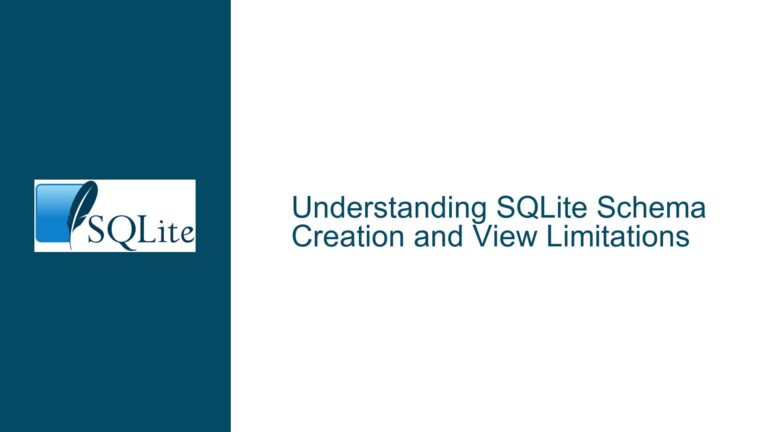the Use of WITH Clause in SQLite CREATE TRIGGER Statements
Issue Overview: The Confusion Surrounding WITH Clause in CREATE TRIGGER
The core issue revolves around the use of the WITH clause, specifically Common Table Expressions (CTEs), within CREATE TRIGGER statements in SQLite. The confusion arises from the apparent contradiction between the SQLite documentation and the graphical representation of the syntax in the form of railroad diagrams. The documentation explicitly states that CTEs are not supported within triggers, yet the railroad diagrams for CREATE TRIGGER show the WITH clause as part of the syntax when expanding SELECT, INSERT, UPDATE, or DELETE statements within the trigger’s BEGIN/END block.
This discrepancy has led to uncertainty about whether the WITH clause can be used within triggers, and if so, under what conditions. The confusion is further compounded by the observation that some SQLite environments do not throw errors when a WITH clause is used within a trigger, even though the documentation suggests that this should not be allowed. This raises questions about whether the WITH clause is being silently ignored, or if there are specific conditions under which it might be allowed.
The issue is particularly relevant for developers who rely on CTEs for complex queries within triggers, as the inability to use CTEs could significantly impact the design and functionality of their database triggers. Understanding the exact limitations and behavior of the WITH clause within CREATE TRIGGER statements is crucial for ensuring that triggers operate as intended and that database schemas are both efficient and compliant with SQLite’s specifications.
Possible Causes: Why the WITH Clause Behavior in Triggers is Ambiguous
The ambiguity surrounding the use of the WITH clause in CREATE TRIGGER statements can be attributed to several factors. First, the SQLite documentation explicitly states that CTEs are not supported within triggers. This is a clear restriction that should, in theory, prevent the use of WITH clauses in trigger definitions. However, the documentation’s clarity is undermined by the presence of the WITH clause in the railroad diagrams for CREATE TRIGGER. These diagrams, which are intended to provide a visual representation of the syntax, suggest that the WITH clause is a valid part of the syntax for SELECT, INSERT, UPDATE, and DELETE statements within triggers.
One possible explanation for this discrepancy is that the railroad diagrams are generated from a generalized syntax specification that does not account for context-specific restrictions. In other words, the diagrams may show all possible syntax elements, even if some of those elements are not allowed in certain contexts, such as within triggers. This would explain why the WITH clause appears in the diagrams but is explicitly prohibited by the documentation.
Another factor contributing to the confusion is the behavior of SQLite itself. In some cases, SQLite does not throw an error when a WITH clause is used within a trigger, even though the documentation states that this should not be allowed. This could be due to the way SQLite processes and validates trigger definitions. It is possible that SQLite does not fully validate the syntax of a trigger until it is actually executed, rather than when it is created. This would explain why some developers are able to create triggers with WITH clauses without encountering errors, only to run into issues when the trigger is executed.
Additionally, the specific use case of the WITH clause within a trigger may also play a role in whether an error is thrown. For example, if the WITH clause is used in a SELECT statement that does not affect the outcome of the trigger, SQLite might not flag it as an error. However, if the WITH clause is used in a way that directly impacts the trigger’s operation, such as in an UPDATE statement, SQLite might then throw an error. This variability in behavior further complicates the issue and makes it difficult for developers to predict when and why the WITH clause might be allowed or prohibited within triggers.
Troubleshooting Steps, Solutions & Fixes: Navigating the WITH Clause in Triggers
To address the confusion and potential issues surrounding the use of the WITH clause in CREATE TRIGGER statements, developers should follow a systematic approach to troubleshooting and resolving these issues. The first step is to thoroughly review the SQLite documentation to understand the explicit restrictions on the use of CTEs within triggers. While the railroad diagrams may suggest that the WITH clause is allowed, the written documentation takes precedence and clearly states that CTEs are not supported in this context.
If a developer encounters a situation where a WITH clause is used within a trigger and no error is thrown, they should not assume that this usage is valid or supported. Instead, they should treat this as a potential issue that could lead to unexpected behavior or errors when the trigger is executed. To avoid this, developers should refrain from using WITH clauses within triggers altogether, and instead look for alternative ways to achieve the desired functionality.
One possible alternative to using CTEs within triggers is to break down complex queries into simpler, more manageable pieces. For example, instead of using a WITH clause to define a CTE, a developer could use a series of SELECT statements or temporary tables to achieve the same result. While this approach may require more code and could be less efficient, it ensures that the trigger remains compliant with SQLite’s restrictions and reduces the risk of encountering errors or unexpected behavior.
Another approach is to use subqueries or joins in place of CTEs. While these techniques may not offer the same level of readability or modularity as CTEs, they can often achieve similar results without running afoul of SQLite’s restrictions. For example, instead of using a WITH clause to define a CTE that is then used in a SELECT statement, a developer could rewrite the query as a subquery or join that achieves the same result.
In cases where a developer has already created a trigger with a WITH clause and is unsure whether it will cause issues, they should thoroughly test the trigger in a controlled environment before deploying it to a production database. This testing should include scenarios where the trigger is executed under various conditions, including edge cases that might expose any hidden issues with the WITH clause. If the trigger behaves as expected and no errors are thrown, the developer may choose to leave the trigger as-is, but they should remain vigilant for any potential issues that might arise in the future.
Finally, developers should stay informed about updates to SQLite and its documentation, as the behavior of the WITH clause within triggers could change in future versions. If SQLite were to lift the restriction on CTEs within triggers, developers would need to update their understanding and potentially revise their trigger definitions to take advantage of this new functionality. Conversely, if SQLite were to enforce the restriction more strictly, developers would need to ensure that their triggers comply with the updated requirements.
In conclusion, while the use of the WITH clause in CREATE TRIGGER statements may seem ambiguous due to the conflicting information in the SQLite documentation and railroad diagrams, developers should adhere to the explicit restrictions outlined in the documentation. By avoiding the use of CTEs within triggers and employing alternative techniques to achieve the same results, developers can ensure that their triggers are both compliant and reliable. Thorough testing and staying informed about updates to SQLite will further help developers navigate this complex issue and maintain the integrity of their database schemas.






